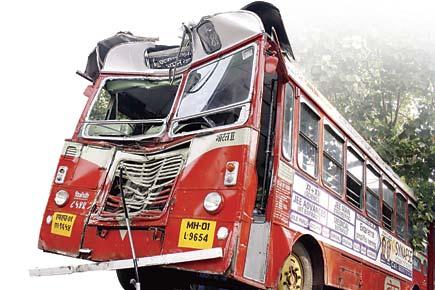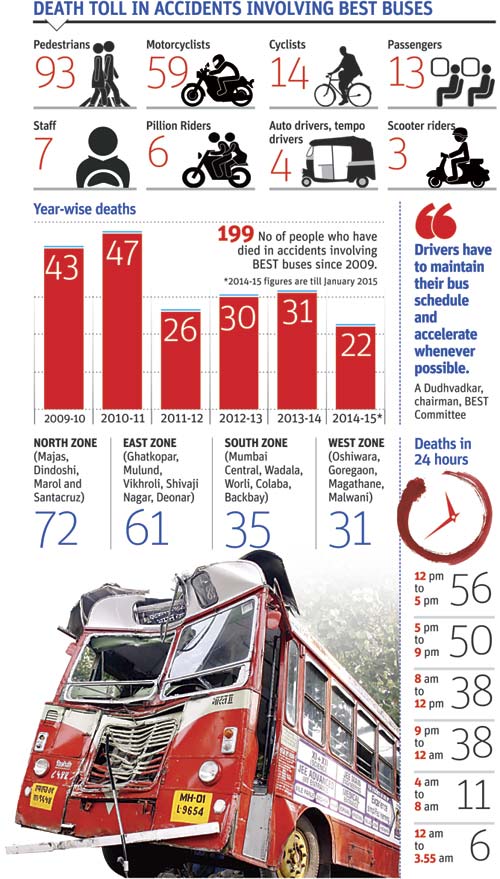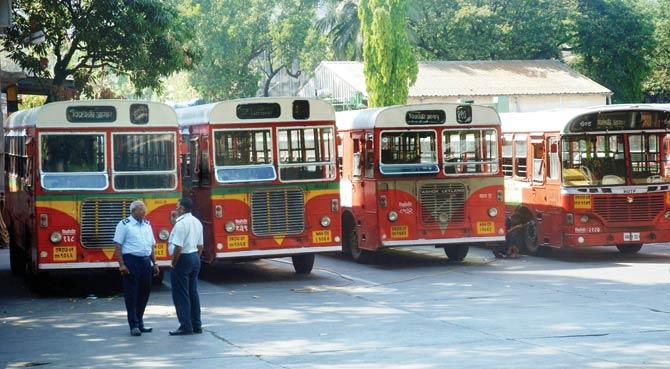Hoping to curb accidents, BEST writes to state for live feed of its bus movements with help of CCTVs. It also decides to get smaller tyres to curb speeding by its drivers and get bigger side mirrors

Safer Mumbai! BEST sees red over rash drivers, launches 3-pronged attack

A double-decker BEST bus had rammed into a tree in BKC last November, injuring at least six passengers. FILE PIC
ADVERTISEMENT
Brihanmumbai Electricity Supply and Transport (BEST) Undertaking’s buses are in the red. No, we are not talking about financial losses or even the colour of the buses, but about the number of fatalities in bus accidents.
From April 2016 to this January, 14 people have died; overall, 198 between 2010 and 2015. In a bid to curb accidents, the Undertaking has now decided to ask the state to provide it with live feed of its bus movements with the help of the 4,500 CCTVs installed across Mumbai.
Under lenseye
Sources said the BEST has also asked for 65 more CCTVs, connected to its control room, for monitoring buses, their movement, and the traffic.
"We have asked the government to extend the CCTV surveillance and provide us live feed," said Jagdish Patil, general manager, BEST Undertaking. They also want to monitor the drivers and their driving skills, identify bus timings and routes on which there are frequent breaches of traffic rules, and keep a watch on accidents. BEST officials said of the total fatalities, 50 per cent are pedestrians, followed by two-wheeler riders (35 per cent).
Under the wheels
Citing the high number of pedestrians' deaths, the Undertaking has tied up with WRI India under the Bloomberg Initiative for Road Safety. Officials said they have kept a budget of Rs 100 crore for this scheme, wherein overall improvement, as far as safety, driving and infrastructure is concerned, shall be taken up.

Survey report by BEST in March 2015
As per the figures collated by WRI India, 67 per cent pedestrians who lost their lives were crossing roads. Most number of the two-wheeler riders who met with an accident collided with the bus on the left-middle and rear side — at least 30 per cent deaths were at the left-rear end.
The eastern suburbs saw the most accidents (43 per cent), while South Mumbai saw the least (12 per cent).
In the driver’s seat
The BEST has claimed that it has begun training and refresher courses for its drivers, which will now happen once every 2.5 years instead of the earlier 4.5, and training has already been started at 12 of the 26 depots.
Drivers are being told about the possible monitoring of their driving and movement with the help of CCTV cameras. A special form too has been created having objective-type questions to detail an accident clearly. From October to December 2016, the BEST received e-challans for 120 drivers who breached traffic rules.
Mirror, mirror...
The Undertaking is also making changes in the side mirrors, testing 380 mm x 190 mm-sized ones; the current are 40 per cent smaller. Officials said if this proves to be helpful to drivers, they will retrofit the new mirrors in the new lot of 303 buses and in all the buses in their fleet currently.
Undertaking to go for smaller bus tyres to curb speeding

There are 12 thousand BEST bus drivers and 3,800 buses in the Undertaking's fleet
The BEST has decided to get smaller tyres for its buses to curb speeding by its drivers. The Undertaking is changing the size of its nylon tyres, mainly as an alternative to speed governor that regulates the speed of vehicles and keeps it under permissible limits.
The move has come at a time when the Road Safety Week is going on and the state government wants to keep an eye on traffic violations and speeding vehicles in a bid to curb accidents.
Sources in the Undertaking said they will be buying 6,500 nylon tyres that are 9.00 x 20-16PR (the technical size of tyres) and replace the 9.00 x 20-14PR. “It is being done to reduce the speeds of buses, making it permissible under the Central Motor Vehicle Rules, 1989,” said Jagdish Patil, general manager, BEST.
The new set of tyres will be put in 775 Tata buses that are a part of the 3,800-strong fleet. These tyres will be procured at a cost of R4.72 crore.
At present, it is must to instal speed governors in heavy vehicles like buses, trucks, trailers and multi-axles. These cost more than Rs 10,000 depending on the vehicle’s weight and size.
Sources in the BEST pointed out that in Mumbai the average speed of buses is 12-14 kmph, and hence, the speed governors don’t fulfill the need.
 Subscribe today by clicking the link and stay updated with the latest news!" Click here!
Subscribe today by clicking the link and stay updated with the latest news!" Click here!






